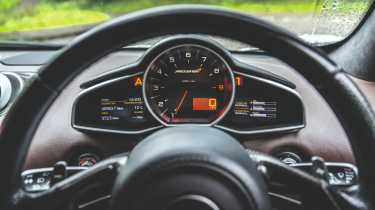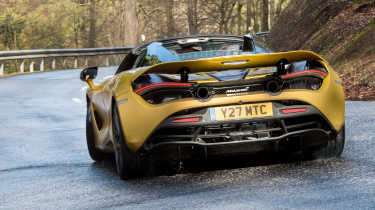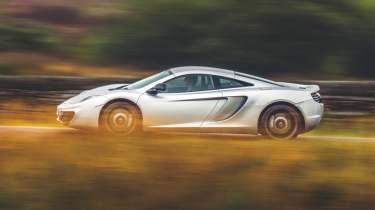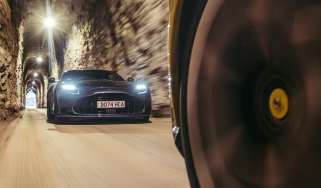How to buy a used McLaren supercar bargain
A used McLaren is as tempting a prospect as it is scary, but with due diligence there are great cars out there to be enjoyed

New supercars are a tough sell these days. Vastly more expensive and more prone to depreciation than they were not so long ago, many buyers are looking to the used market to get their exotic kicks. Great cars of just a few years ago are out there for half or less than the sticker price of a new McLaren 750S or Ferrari 296 GTB. Especially tempting are McLarens, because what are incredibly usable yet thrilling supercars tend to carry a price so much lower than that of a comparable Ferrari or Lamborghini of the same age from the same segment.
Their values are where they are for a reason, however. Nevermind the questionable ‘fill the dealers with stock’ tactic McLaren was infamous for that unsettled the delicate supply/demand balance when new, buyers are also somewhat frightened of cars with a reputation deserved or not, for unreliability and big bills. But a McLaren 12C for the price of a four-cylinder Porsche Cayman is impossibly tempting. The question is, would you dare?
With a bit of due diligence, we reckon a used McLaren could be a great buy, if you buy carefully. To get an idea of exactly what specific models to target and what issues there are to look out for, we tapped up McLaren specialist John Thorne of Thorney Motorsport.
How to buy a used McLaren
There are common issues across all McLarens you need to look out for that we’ll get into in a bit but apropos those, Thorne’s first piece of advice is thus: get a proper inspection. A 12C on an online auction at no reserve might look seriously tempting but without the ability to look at, or have it looked over properly, you might be paying £60k for a car with £30k or more of remedial work in its future. The amount of work Thorney's team finds on each car it inspects averages out at around £10k, with much higher and much lower figures across the range, depending on the quality of the car being inspected – something worth knowing before money changes hands.
It probably goes without saying but it’s a red flag when an owner won’t allow a proper inspection of their car too. Thorne gave a very common sense analogy: ‘You’d get a survey of a flat and be put off if the owner wanted to do it themselves or wouldn’t let you. Why does the same logic not apply to a car you're paying as much for?’.
Secondly, pricing – don't go for the cheapest there is. Low prices could mean higher miles, patchier service history and a higher likelihood that expensive gremlins await. 12Cs might be out there for under £60k but the cars you want, that will cost you less when it comes to maintenance, realistically aren’t available for less than £70k. Likewise there are 600LTs and 720s out there for £120k, but the good LTs cost no less than £135k and the good 720Ss no less than £140k, if you’re looking to avoid common and pricey issues. Thorne reckons there isn't a £120k 720S out there that doesn't need at least £35k of work.
Spiders tend to carry a premium of between £10k and £30k. Spec is a worthwhile consideration too – cars with carbon trim, whether inside or out, and the bucket seats carry a premium. Here's a table showing what you can expect to pay at minimum for McLaren examples worth owning. Note, not what McLaren examples are available at at their cheapest.
| Budget | McLaren |
|---|---|
| £70k - £80k | Early 12C, 570S, 540C |
| £80k - £90k | 12C Spider, 650S |
| £90k - £110k | 650S Spider, 570S Spider, GT |
| £130k – £160k | 600LT, 600LT Spider |
| £150k – £180k | 720S, 720S Spider |
Common McLaren issues and what to look out for
There are issues that all McLarens will eventually have, that you should look out for on your hunt. Or rather, the inspections you have done should reveal they are absent from the car you’re looking at.
Whether on Super Series or Sports Series, bubbling paint is a common issue. Sometimes it’s due to alloy corrosion, sometimes it’s because water has gotten between the composite panels and the paint, often meaning a full panel strip-back and respray is needed. Thorne says £1200 per panel is a ballpark figure, for an issue most commonly seen on 600LTs. Another point to look out for across all models is snapped springs in the suspension.
Every McLaren (bar the Artura) also has a version of the flat-plane crank twin-turbo V8 engine, whether in 3.8-litre or 4-litre form. Because of the way the oiling system works, these engines start ‘dry’, meaning it takes a moment for the internals to get properly lubricated, which is why cold start revs are an especially bad idea on these cars. Listen out for an untoward ticking sound that lingers more than a few seconds after startup. This could be a sign of a car that will need top-end rebuild work sooner rather than later, costing £8k - £15k. The water pump should be high up on the inspection list too, as leaks are common.
Avoid tuned cars – sports series models will suffer undue wear on their aluminium cylinder liners while the standard conrods on 4-litre cars don’t stand up well to increased boost. A full rebuild is £25k+... Listen carefully for a rattle on the downpipe heat shields of all V8 cars, as these are prone to failure and are expensive to replace. If left unattended, things can get melty. The dual-clutch transmissions too, are known for input shaft bearing wear that results in a fluid leak. Gearbox rebuilds are around £10k.
The most famous issue specific to super series cars – from the original 12C to today’s 750S – is to do with the interconnected hydraulic suspension system known as Proactive Chassis Control. The four fluid accumulators (one at each corner) are considered a wear and tear item and can be refurbished at £2000 per corner, with work generally needed around every five to six years. A fully tired suspension system – leaky accumulators, leaky dampers and snapped springs all round – is an expensive remediation job. Untoward thunks in the direction of one of the car's corners could suggest broken springs, leaky dampers, tired accumulators or tired suspension arms. Super Series cars all feature hydraulically actuated active aero too, though Thorne says air brake ram failures are rare.
On sports series cars specifically, Thorne says door hinge cracks are really common, too, even an inevitability. It's even worth checking your radio works, as faults in the infotainment can be costly to remediate. As for what not to be terrified of? Early 12Cs – apparently, Thorne hasn’t seen a single failure of the controversial swipe-to-open door handle.
What McLaren do you buy?
Each McLaren model has its quirks and kinks but, contrary to some prevailing wisdom, Thorne doesn’t discourage based on model year or model line, though cars during the first model years did tend to have the most issues, that should by now be ironed out. ‘There’s no discernible difference between model years,’ Thorne says. ‘It’s mostly cobblers’.
Spiders come highly recommended. They do carry a premium but Thorne’s advice is if you can afford a Spider equivalent that’s not at the bottom of the barrel, go for one. There are a few reasons why. In the case of the 12C, 570S and 720S, they’re models that arrived a couple of years after the coupes and therefore, for the most part, came after the common production kinks were ironed out.
As they arrived later but stopped at essentially the same time as their coupe equivalents, they’re also rarer and so ought to not depreciate as sharply. 720S Spiders for instance, were only available for around 18 months in the UK. There’s also very little dynamic downside, as we’ve come to learn over McLaren Automotive’s 15 years, no structural rigidity is lost in the Spider transformation thanks to it all being inherent to the carbon tub.
Thorne also says to not be afraid of early 12Cs. If they’ve been looked after, they’re fine with the usual caveats around inspections. The first 100 cars were built by MSO, not on the MTC production line and so are thought by some to be of a higher quality. Even the swipe-to-open door ‘handles’ are said to be reliable, if a pain sometimes to use.
The best all-round McLaren and the best value right now, according to Thorne, is the eCoty-winning 720S. Near-hypercar performance, great refinement on the road but also control and circuit capability thanks to the PCC system, with good cars available from £150k+. These cars depreciated severely when new due largely to McLaren’s rollout strategy – good news for used supercar prospectors.
The 600LT is a great track car (and another eCoty winner) but Thorne warns these aren’t the best-built McLarens. He also says a good 540C or 570S with some choice upgrades can be all the track attack weapon you could want and need, if real performance rather than concours kudos is what you're after.
Thorne also says the McLaren GT is vastly overlooked and underrated. While reviewers found the broad remit as a supercar and a grand tourer resulted in a car that wasn’t particularly masterful as either, away from comparison tests and in the real world, they’re a great prospect, even if the looks aren’t to all tastes. Partly because they were possibly the worst for depreciation and are a great price now and partly for their usability and the reality that they’re still great dynamically, with a strong 4-litre engine. He even thinks they sound the best.
Ultimately, when it comes to McLarens, it sounds like there are as many gems out there as there are duds. Do your due diligence and you can have a carbon-tubbed supercar at a sports car price – just get it inspected and buy one at the right price, rather than scraping the bottom of the barrel. They’re there for a reason. Better yet, buy one from a specialist. Thorne’s summary speaks volumes: ‘If you buy one that needs work, it’ll make your eyes bleed. If you get a proper one, it’ll be lovely.’ With thanks to John Thorne of Thorney Motorsport for the comments.











